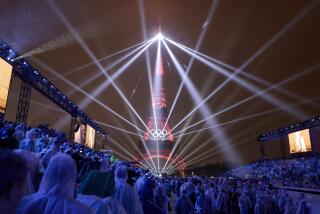Elizabeth II, Mitterrand Inaugurate Channel Tunnel : Europe: The heads of state meet in Calais, then take historic ride on Le Shuttle in the queen’s Rolls-Royce.
LONDON — Queen Elizabeth II and French President Francois Mitterrand inaugurated the English Channel tunnel Friday, the first land link since the Ice Age between the island of Britain and the European Continent.
Both heads of state opened new rail terminals in their respective capitals of London and Paris before meeting at Calais, France, for a ride through the tunnel, which cost $15 billion and took seven years to build.
The queen, speaking in French, described the tunnel, dubbed by many the Chunnel, as one of the world’s “great technological achievements.”
“To rejoin what nature separated some 40 million years ago has been a recurring dream of statesmen and engineers for several centuries,” the queen said. “This is the first time in history that the heads of state of France and Britain have been able to meet each other without either of them having to travel by sea or air.”
After traveling through the tunnel by a sleek Eurostar train from a new terminal at Victoria Station in London, the queen met Mitterrand for ceremonies in Calais, then they both got into her Rolls-Royce and boarded Le Shuttle for the return trip to Folkestone.
Le Shuttle and Eurostar are the twinned trains that will carry passenger cars and freight trucks through the tunnel, one tube in each direction with a service tunnel separating them that can carry emergency vehicles. Motorists will drive their vehicles onto the trains at each end for a half-hour, 31-mile trip in either direction, then debark to expressways at Calais or Folkestone.
But because of delays in the arrival of special tunnel cars and communications equipment, the passenger traffic service will not start until sometime in the autumn.
The Chunnel completion itself has been plagued over the years by delays and cost-overruns--the project cost almost double the original estimates. Further, the British have been years behind the French in providing a high-speed rail link to the Chunnel. For the next several years, while their French counterparts zip along, trains on the British side will travel at speeds well below 100 m.p.h.
In recent days, some experts questioned the safety and reliability of the Chunnel, burrowed well under the channel seabed. To counter any terrorist threat, teams of police will be poised at entrances with equipment to detect explosives, the operators say.
At its best, the Chunnel will soon offer a three-hour rail journey between London and Paris or Brussels. Ferry operators claim that they will eventually be able to lower their prices and suggest that their services will be more reliable, especially in the upcoming early months when post-construction bugs are still being worked out.
Chunnel supporters say the rail trip between London and Paris or Brussels eventually may be reduced to little more than two hours; they see as many as 15 million people making the trip every year--with 60 trains a day, each carrying up to 800 people.
On a political level, some in Britain suggest that the physical link will bind this country closer to the Continent.
More to Read
Sign up for Essential California
The most important California stories and recommendations in your inbox every morning.
You may occasionally receive promotional content from the Los Angeles Times.










